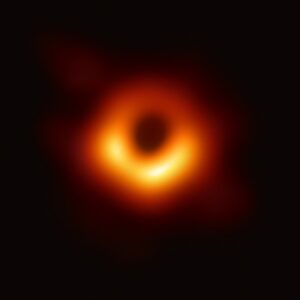Gravitons, particles thought to transmit gravity, have never been observed. But something very similar has now been discovered in semiconductors.
Physicists have been searching for gravitons for decades. These are the virtual particles that are thought to transmit gravity. These gravitational particles are not found in real life. But a group of physicists now claim to have observed particle-like excitation, or “quasiparticles”, in semiconductors that look exactly like gravitons.
Physicists can use these graviton-like particles to understand the behavior of real gravitons. This can help reconcile general relativity and quantum mechanics, which conflict with each other.
Read also
Heino Falk was the first to photograph a black hole: “It's even more beautiful than I expected all along”
Heino Falk, professor of radio astronomy, took the first image of a black hole in 2019. He is currently conducting research…
An elusive particle
“This discovery is like a needle in a haystack,” says the physicist. Lauren Pfeiffer From Princeton University in the United States. He wrote the publication that started it all in 1993. He did it with several colleagues, including physicists Aaron Pinchuk, who died in 2022 before the team found evidence of the elusive particles. Thirty years after its publication, Pinchuk's students and colleagues, including Pfeiffer, completed the experiment. The team published its results in the scientific journal nature.
Quantum spin
The team conducted their experiment with electrons in a flat plane of the semiconductor gallium arsenide. They placed it in a powerful refrigerator and exposed it to a strong magnetic field. Under these conditions, electrons behave strangely due to quantum effects. They interact strongly with each other, forming an unusual, incompressible fluid.
This fluid is not calm, but it shows collective movements in which all the electrons move together. These collective motions are called “quasiparticles” because they behave like particles.
To investigate the quasiparticles, the team shined a carefully tuned laser beam at the semiconductor and analyzed the light bouncing off it. This showed that the excitation had the kind of quantum spin that only gravitons were previously assumed to have.
Quantum spin is a property that you can think of as the spin of a particle, but not quite. Although the team's discovery is not an actual graviton, it is the closest thing physicists have discovered so far.
Excitement
We knew that graviton-like excitations could exist in our semiconductors, says the physicist Xiu Liu from Columbia University in New York, who participated in the experiment. However, it took years before researchers got an experiment accurate enough to detect the special particles. “In theory the story was more or less complete, but in experiments we weren't really sure,” Liu says.
The experiment is not a true analogy of space-time. Electrons are confined to a flat, two-dimensional space, and move much more slowly than objects covered by the theory of relativity. However, the physicist says the experiment is “very important.” Kun Yang from Florida State University, who was not involved in the study. Yang says the experiment bridges the gap between different branches of physics, such as materials physics and theories of gravity, in a way that was not appreciated before.
Quantum gravity
We should be careful to equate this new result with the discovery of real gravitons, says the physicist Zlatko Babić, from the University of Leeds in the United Kingdom. The two are similar enough to use electron systems as a testing ground for some theories of quantum gravity. But you can't use this new result to study every quantum phenomenon at the cosmic level in space-time, Babik says.
The links between this particle-like excitation and theoretical gravitons also raise new ideas about exotic electron states, the physicist says. Lingji Du from Nanjing University in China, who also participated in the study.

“Total coffee specialist. Hardcore reader. Incurable music scholar. Web guru. Freelance troublemaker. Problem solver. Travel trailblazer.”








More Stories
GALA lacks a chapter on e-health
Weird beer can taste really good.
Planets contain much more water than previously thought